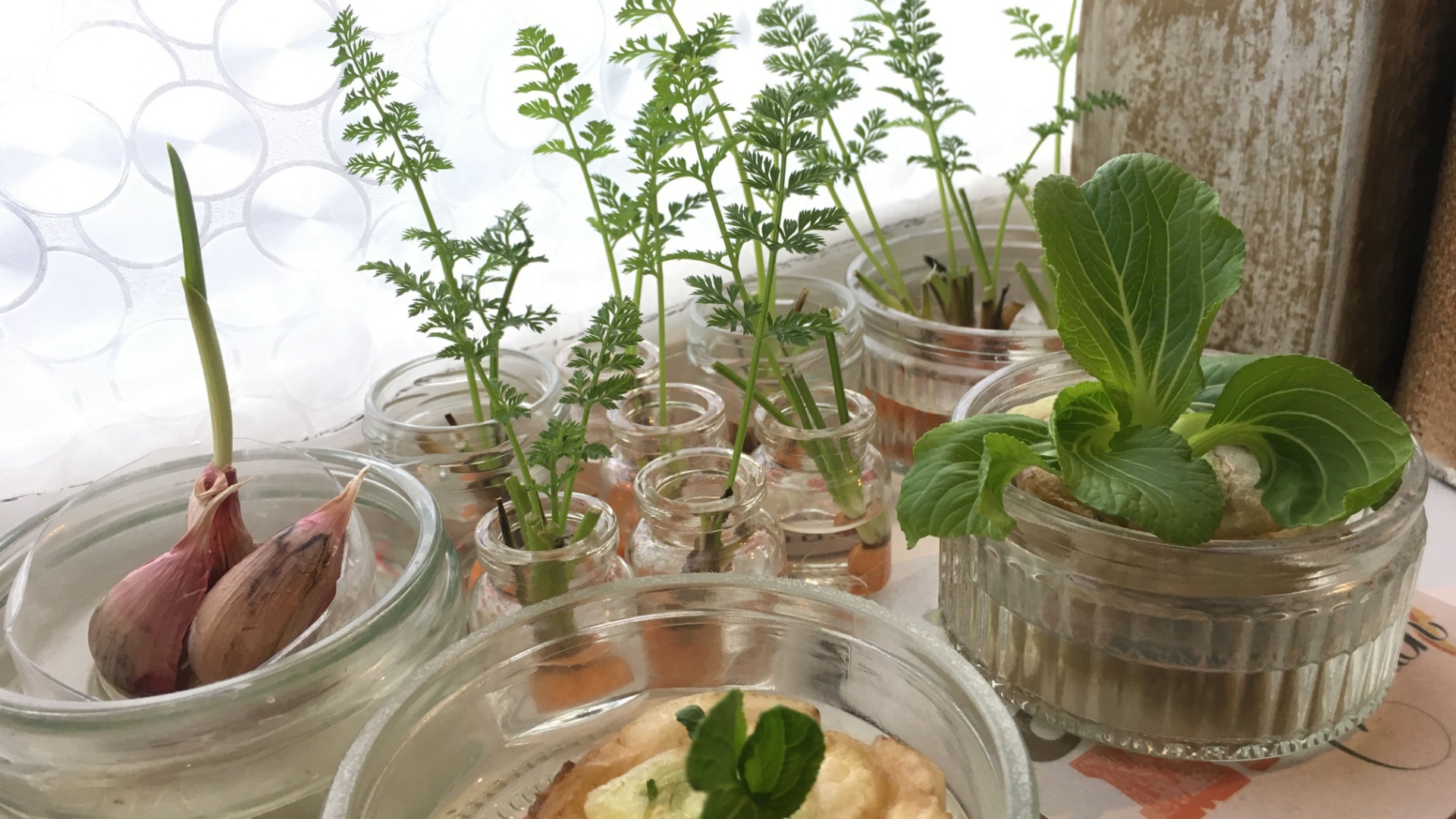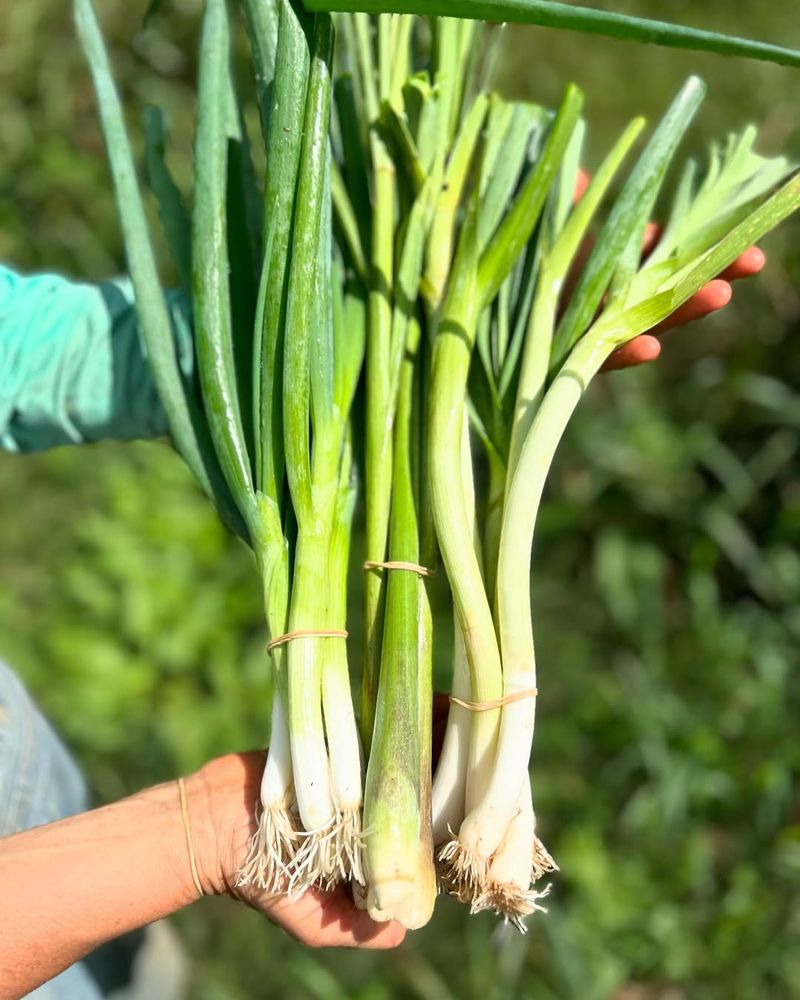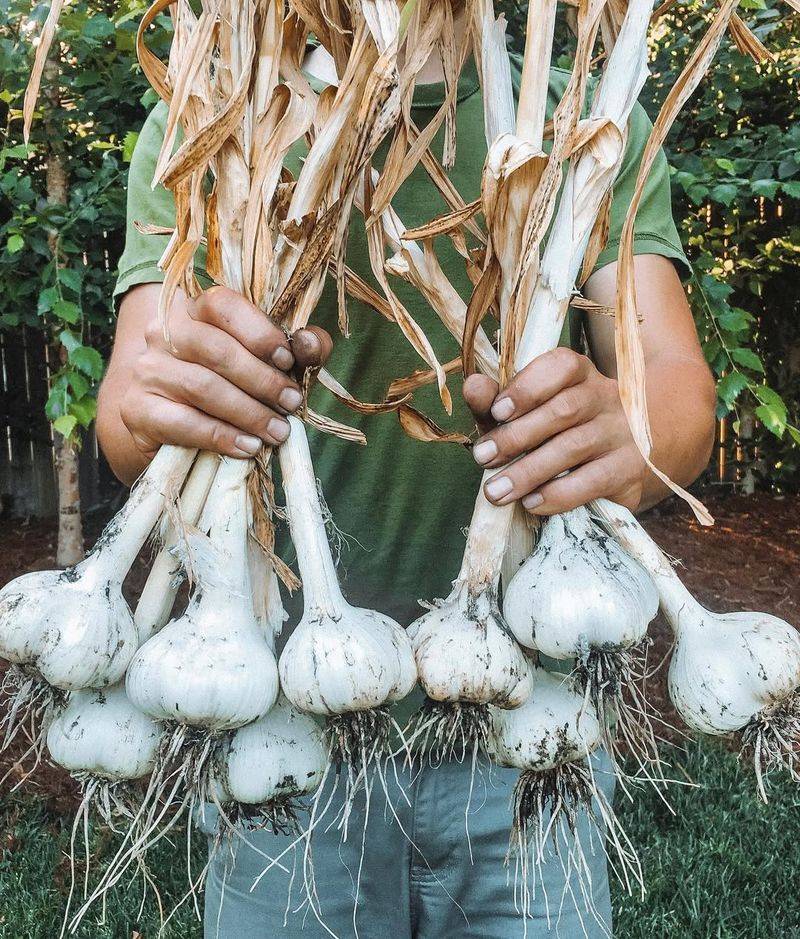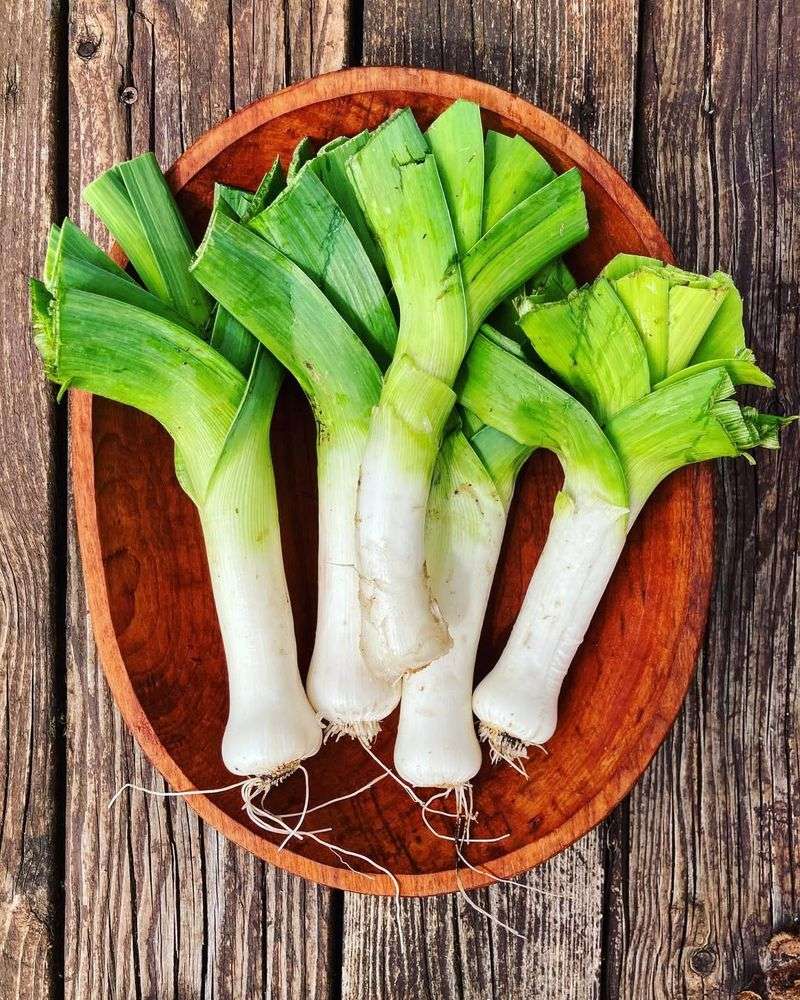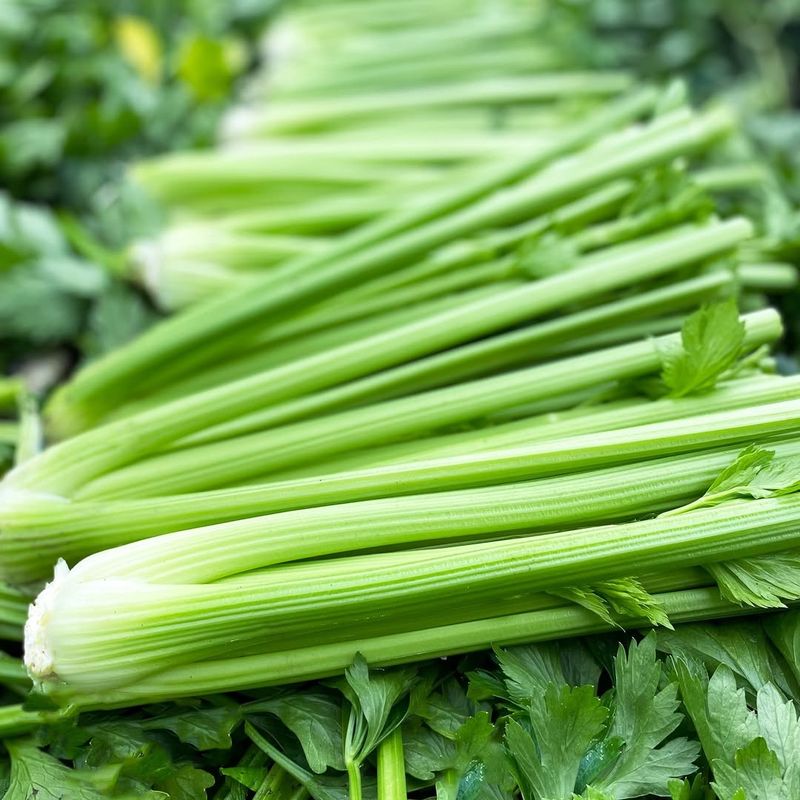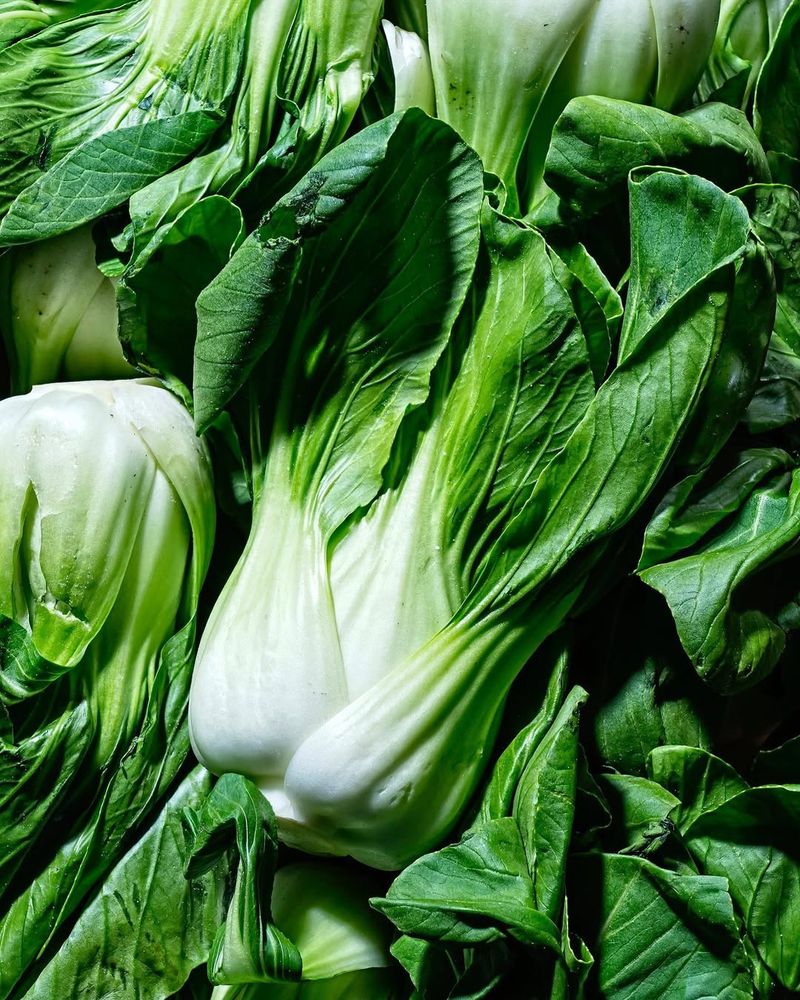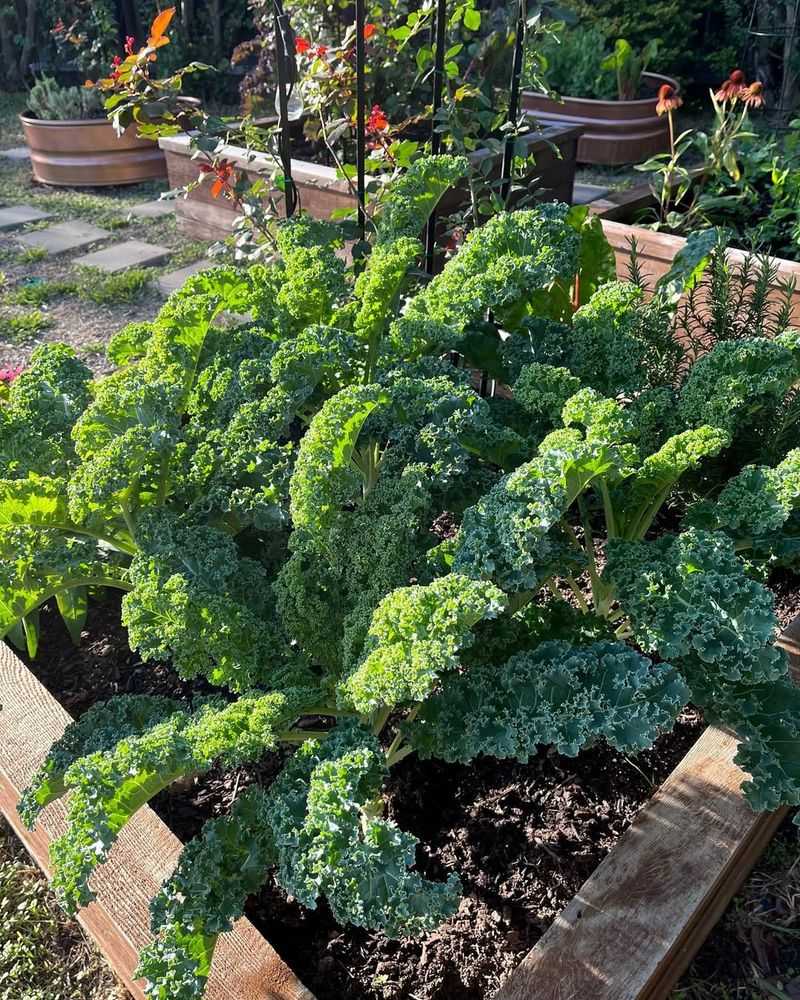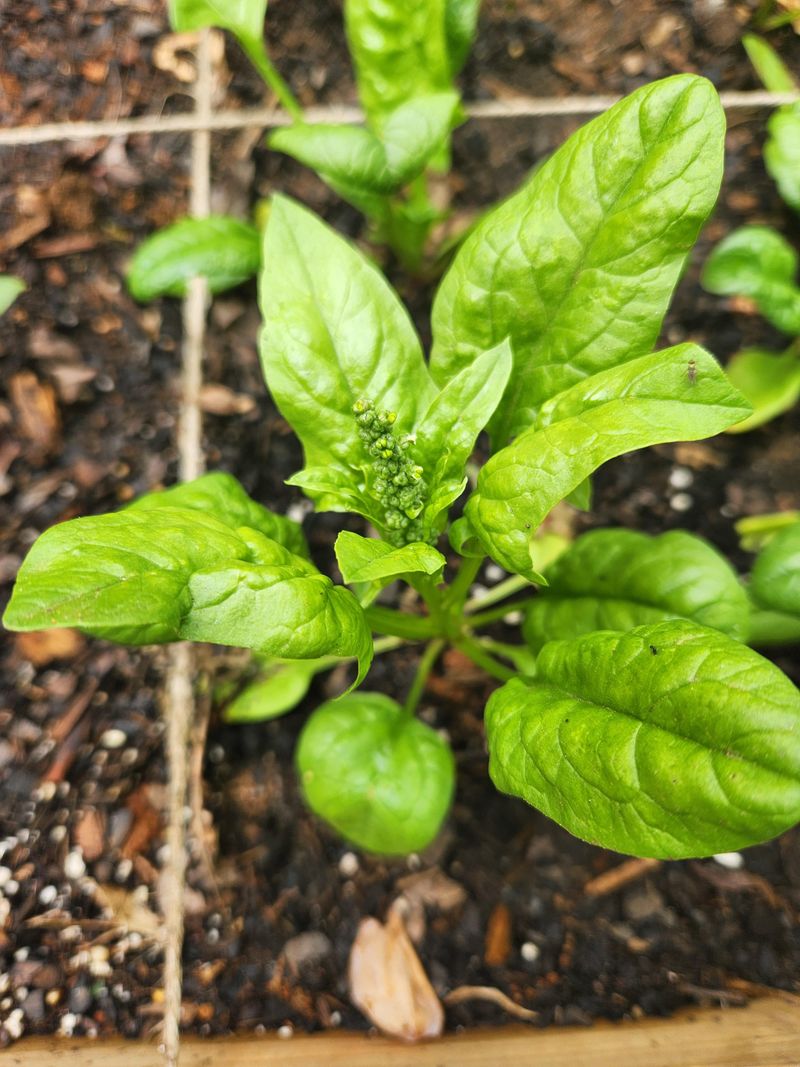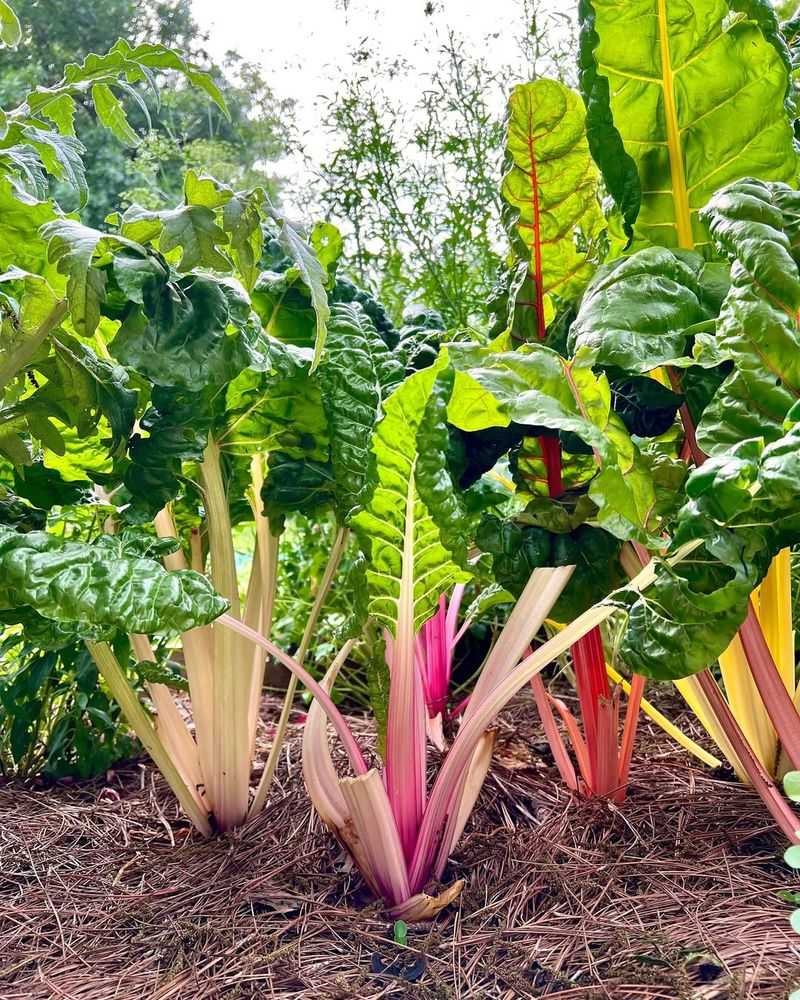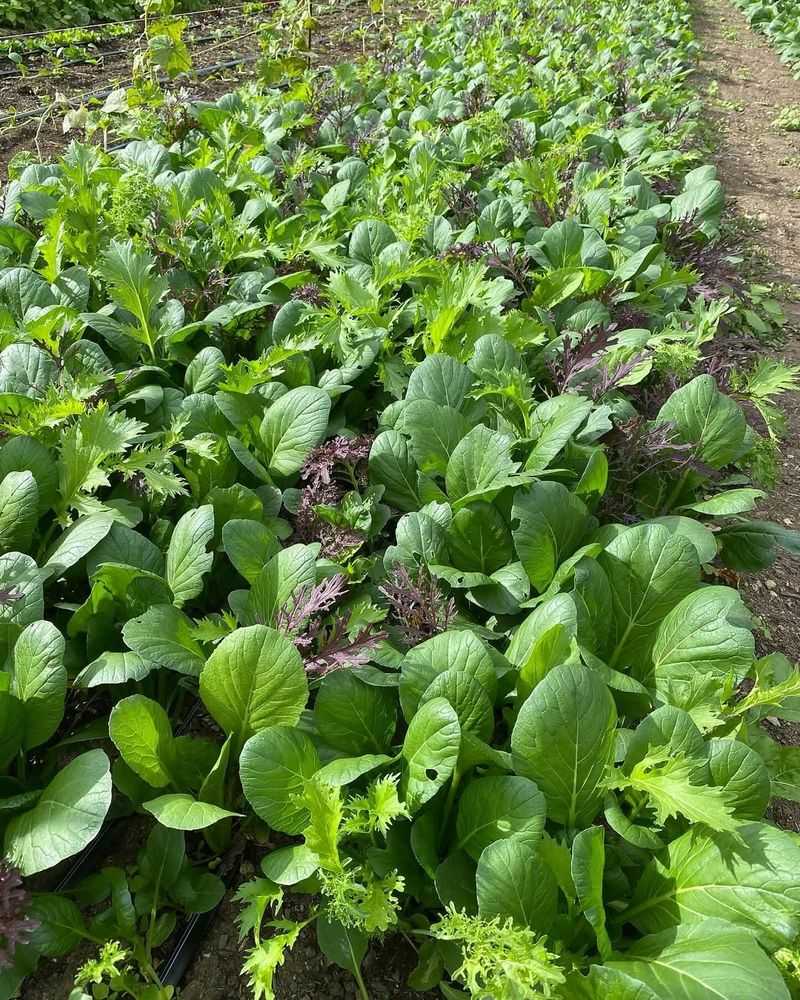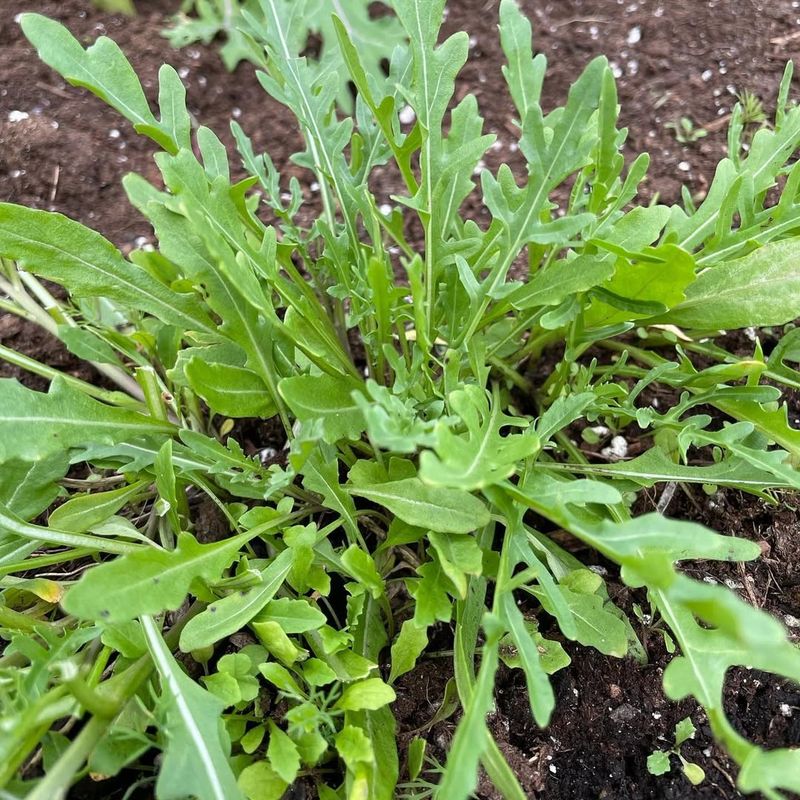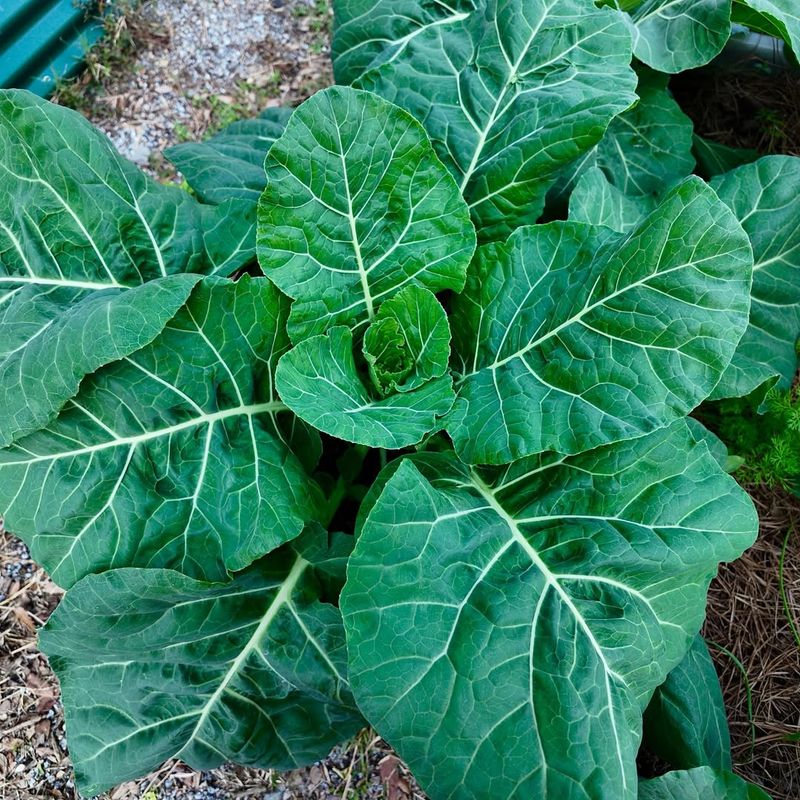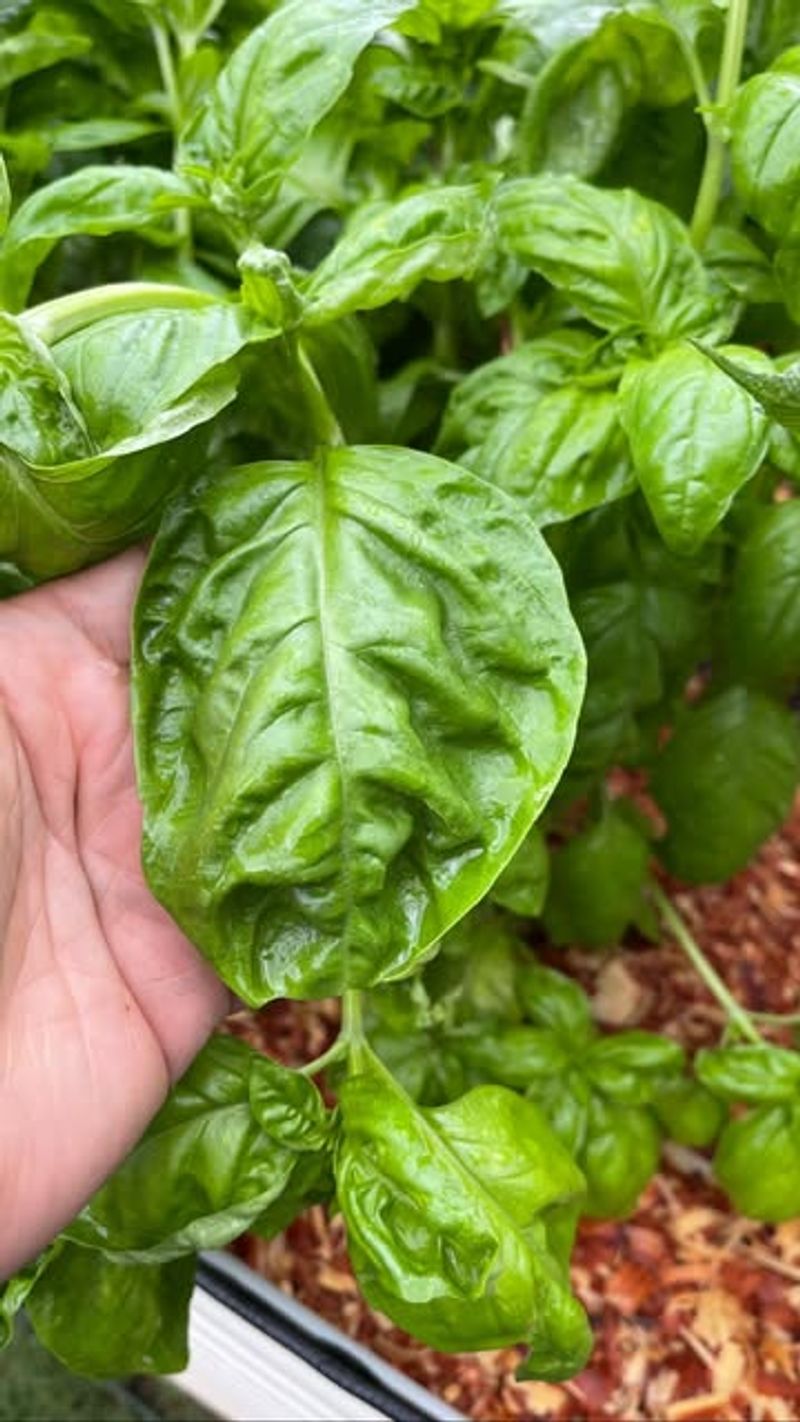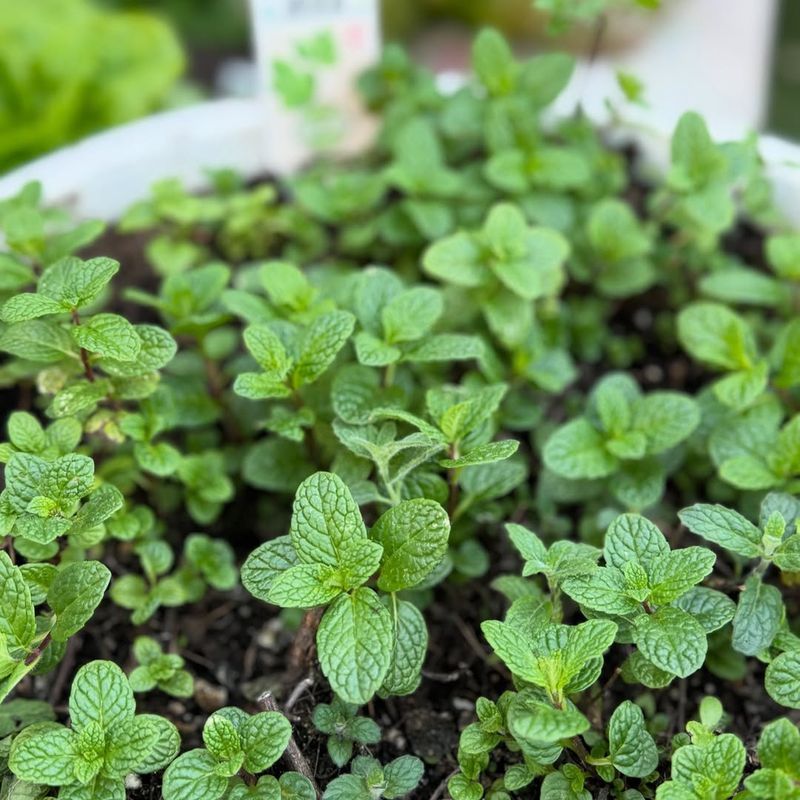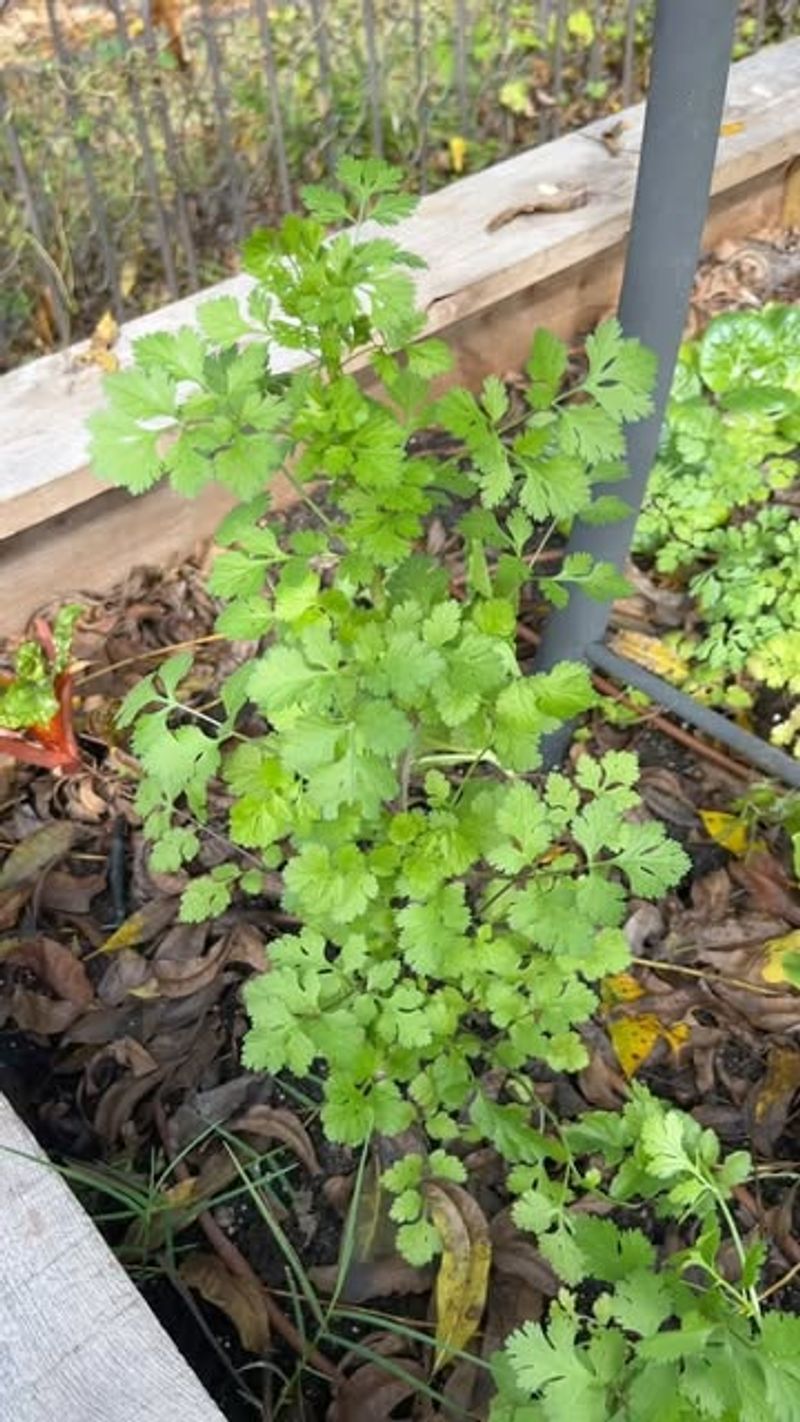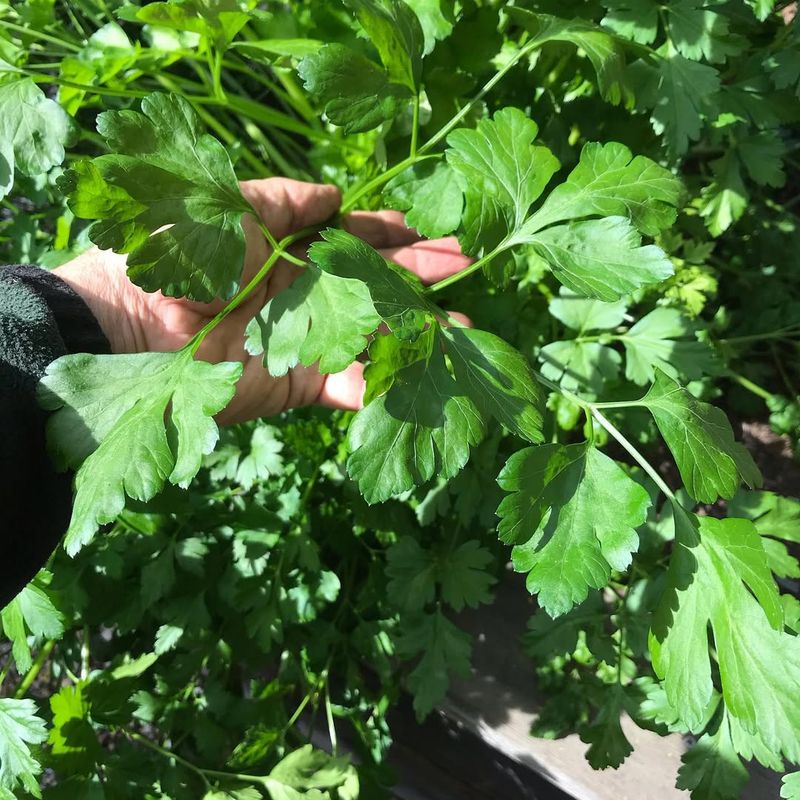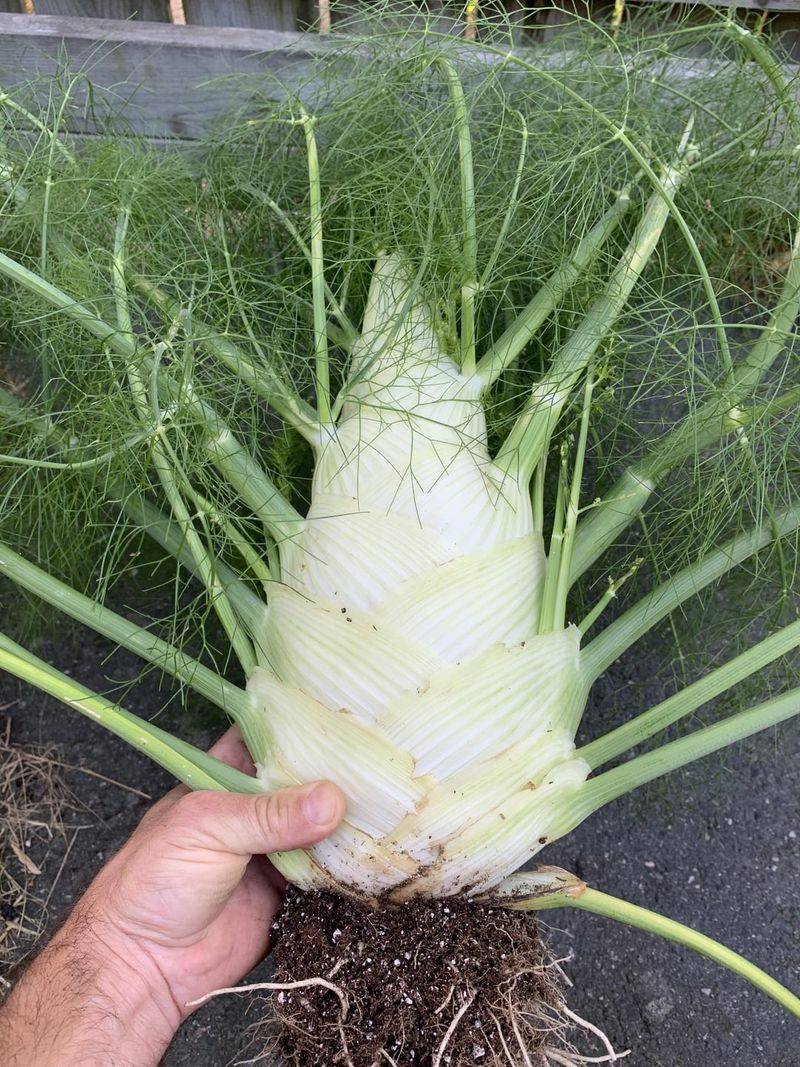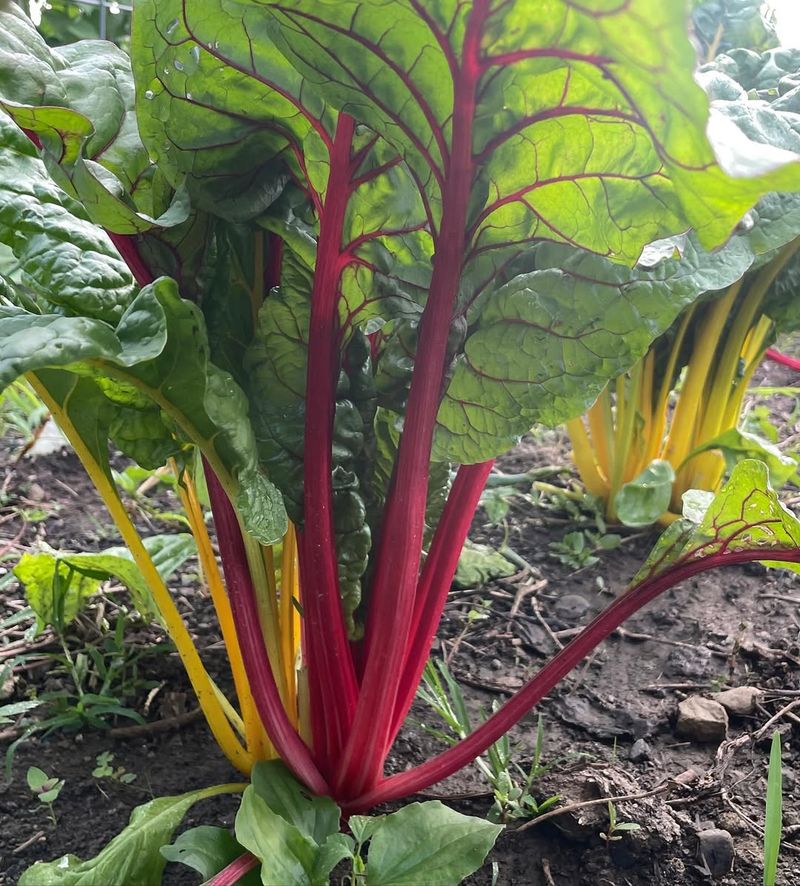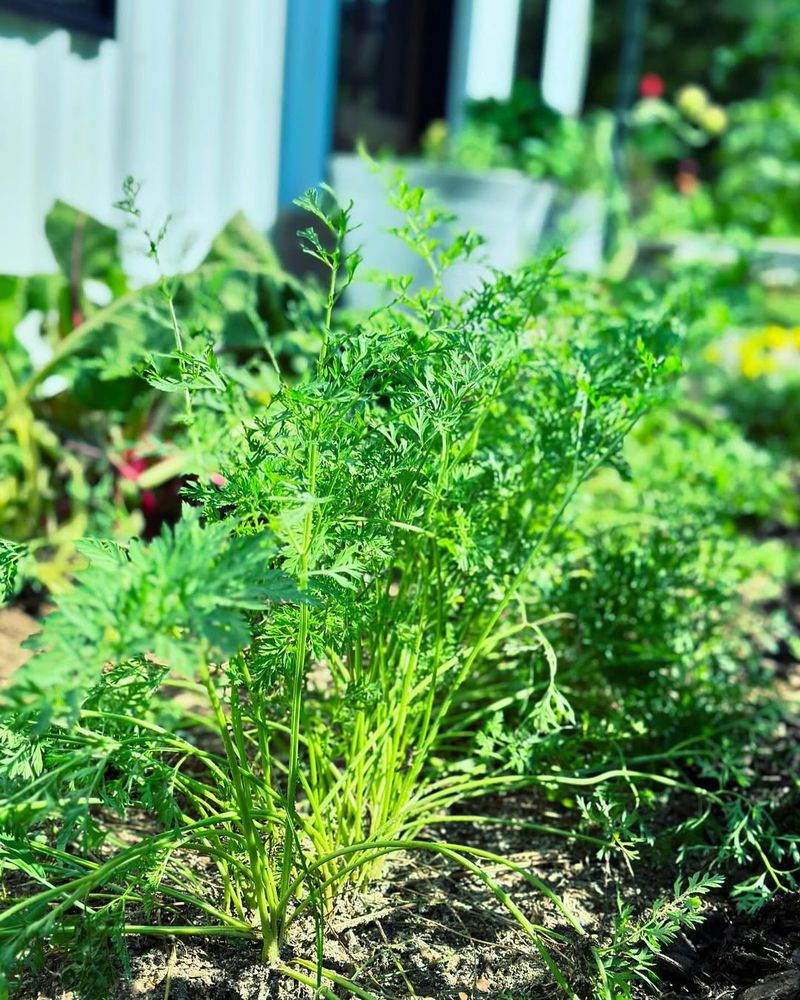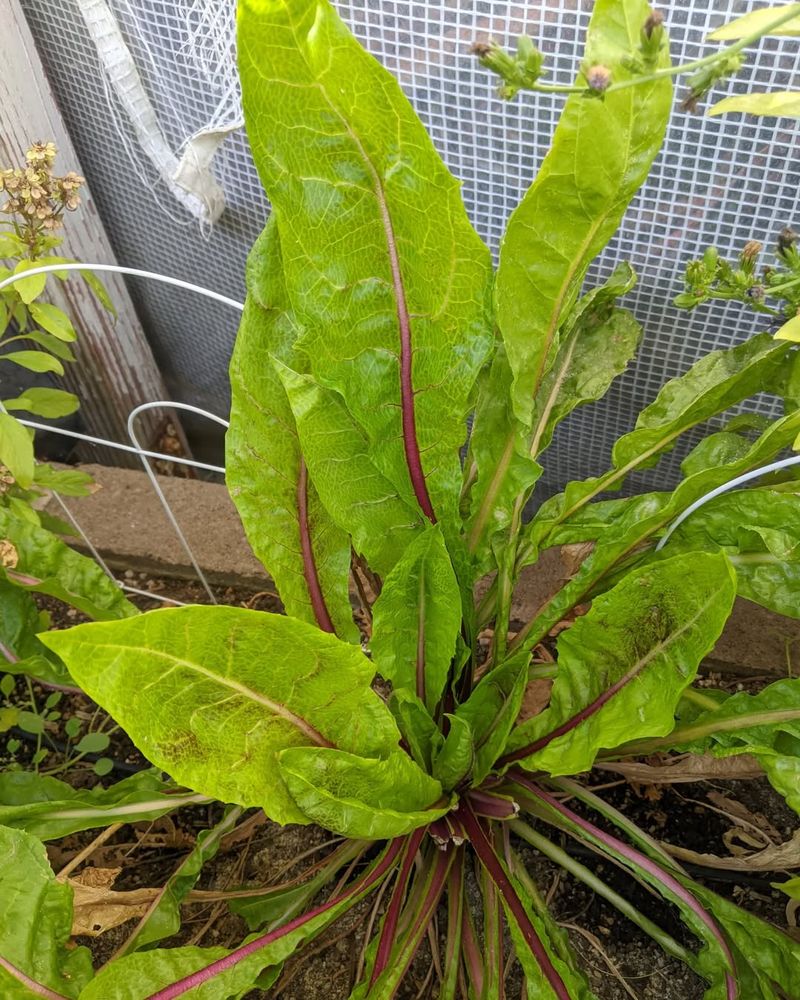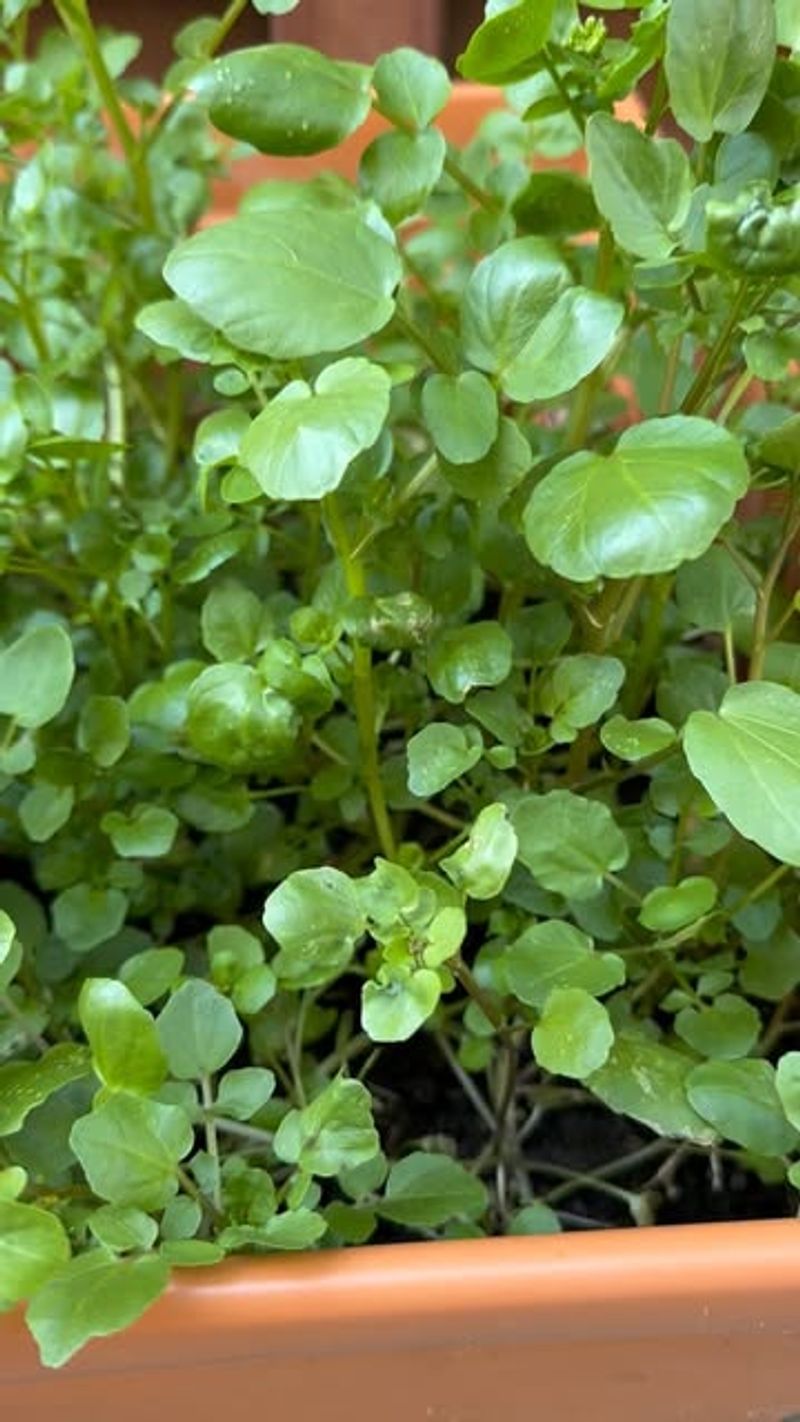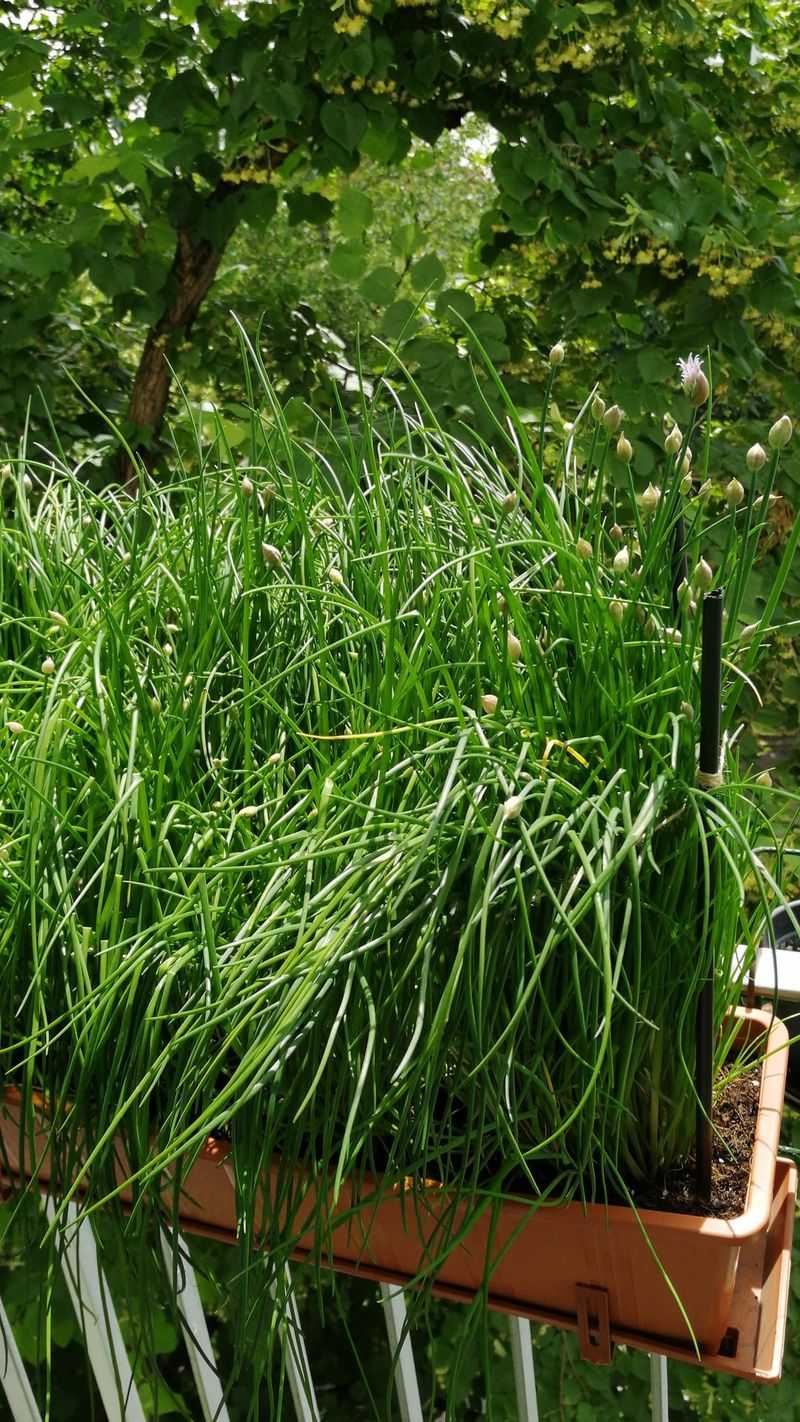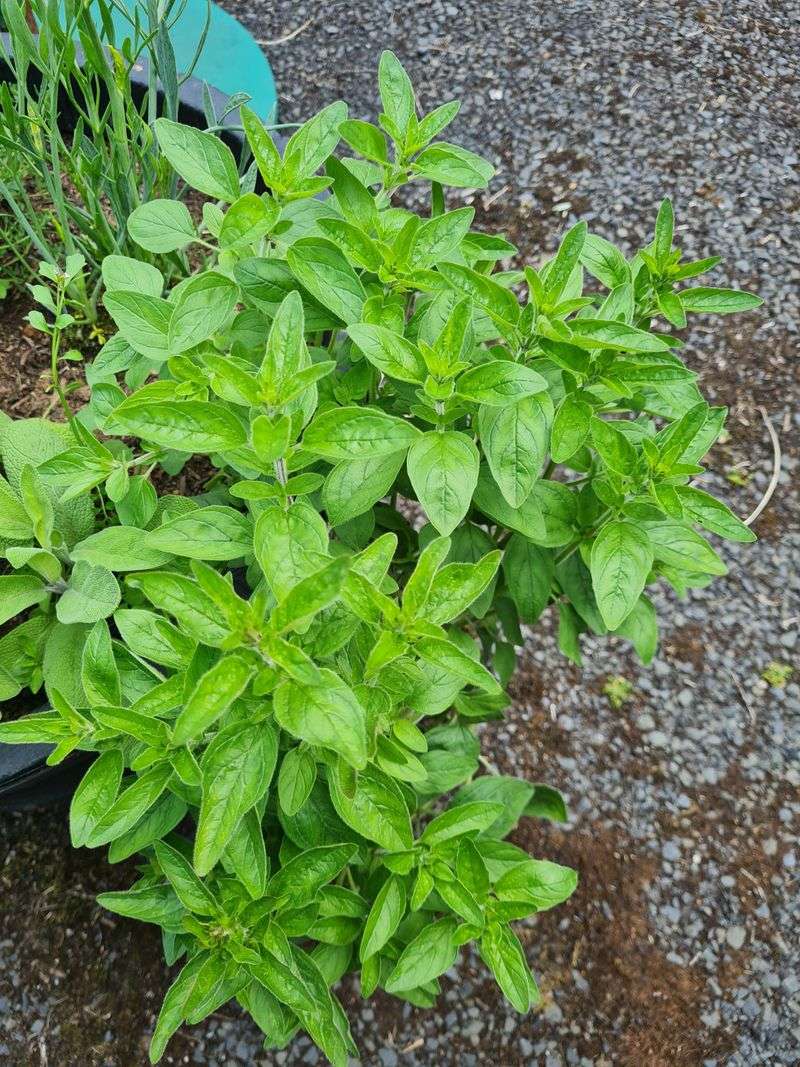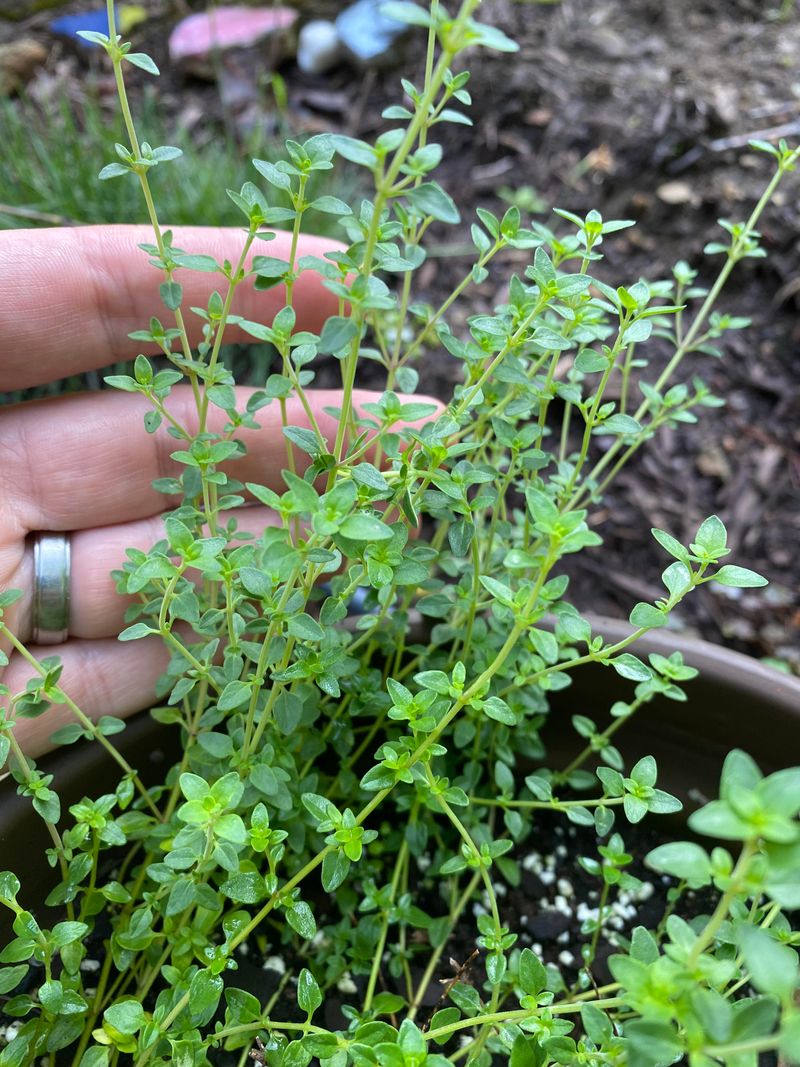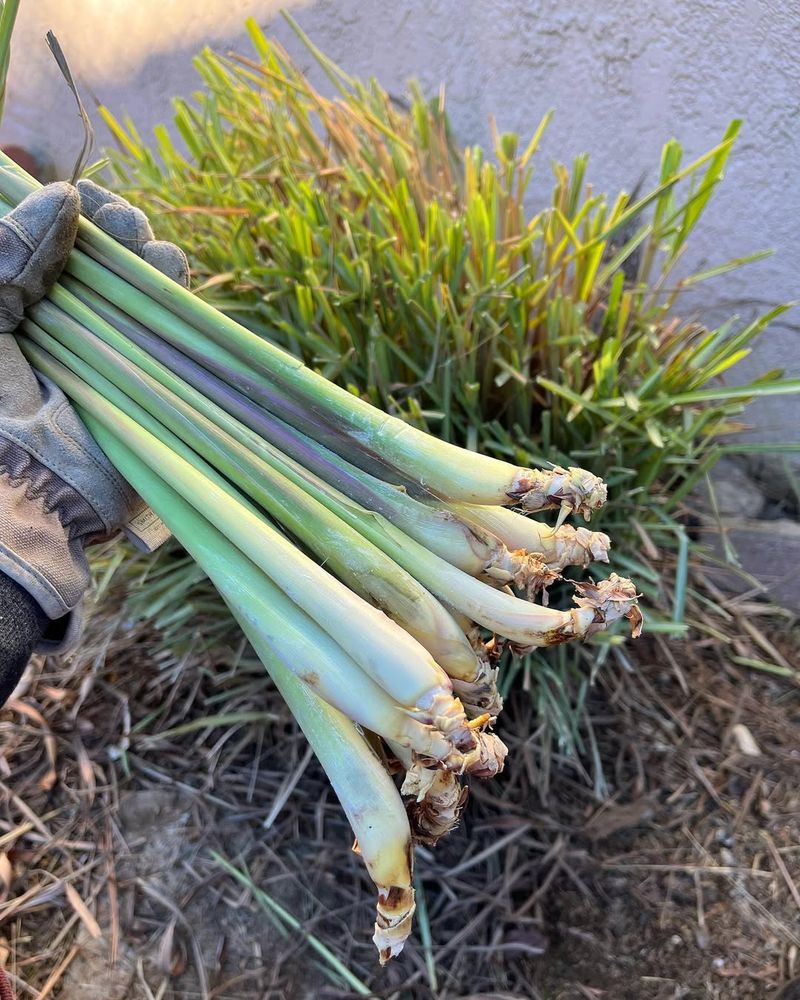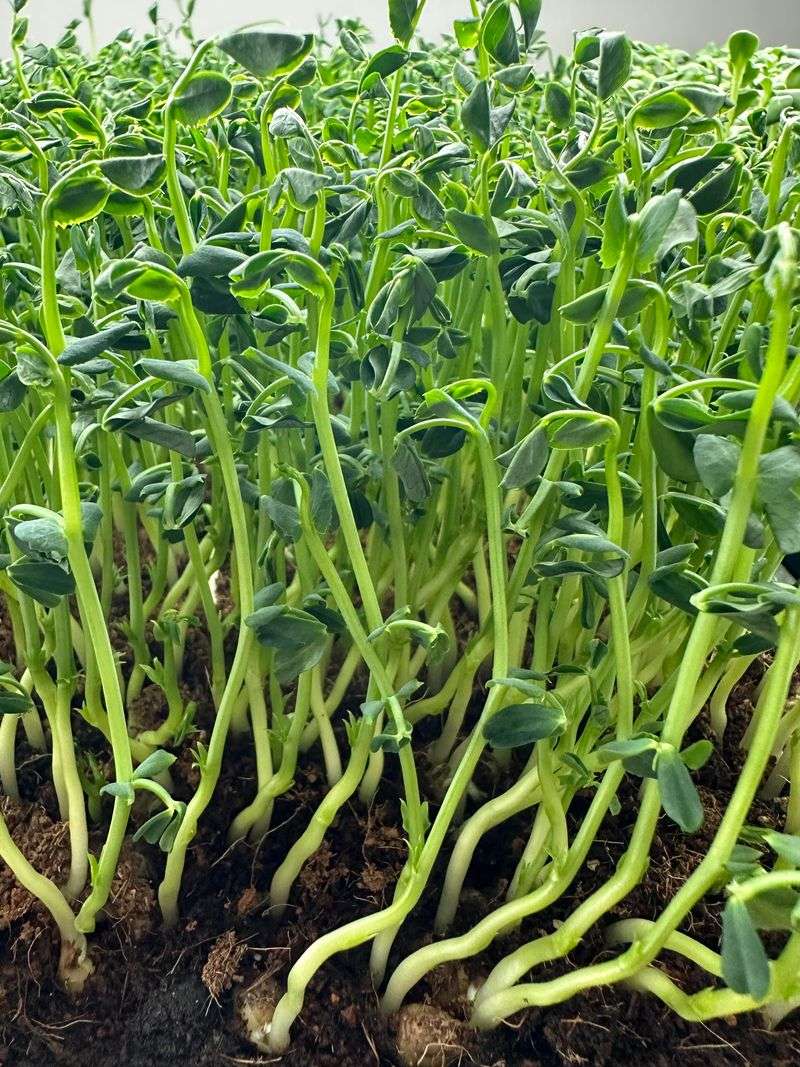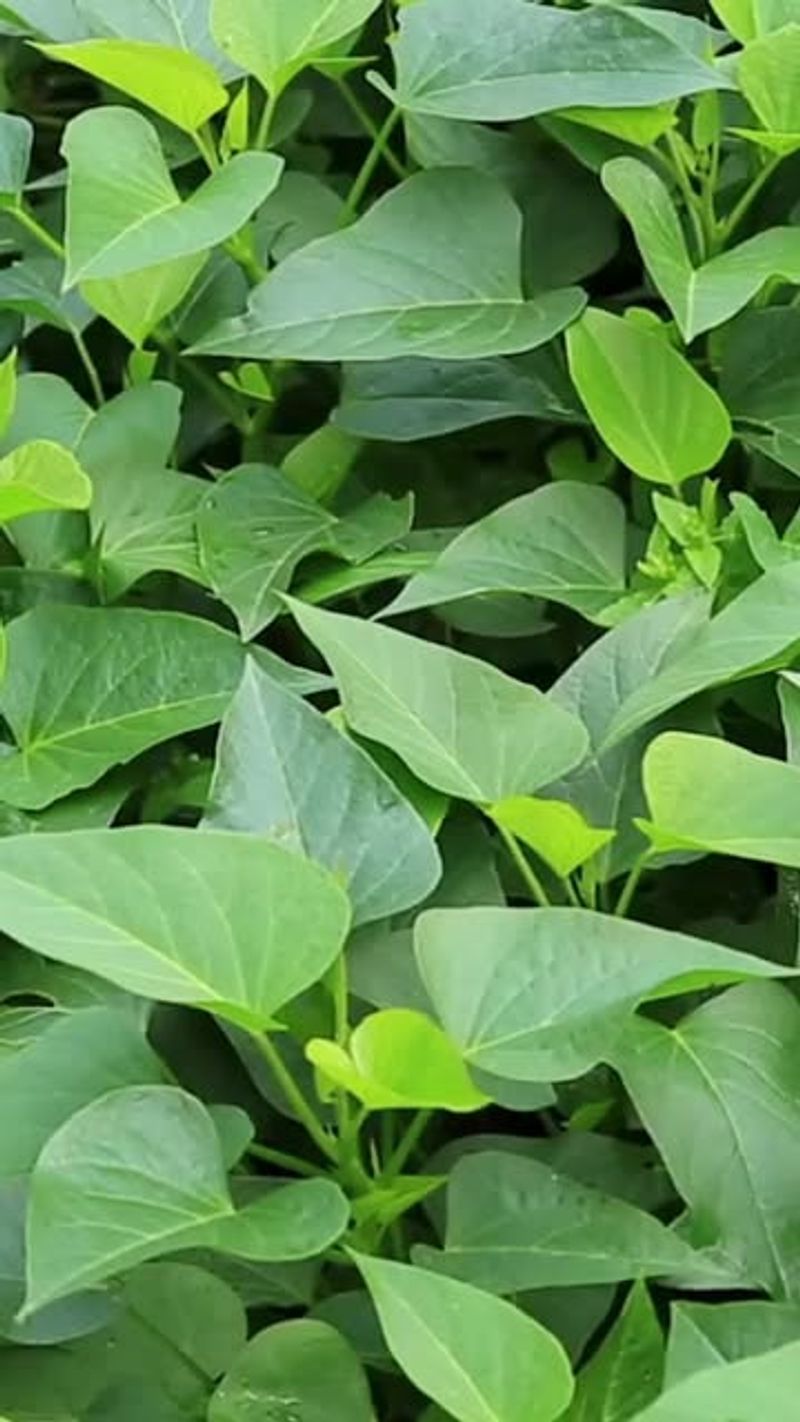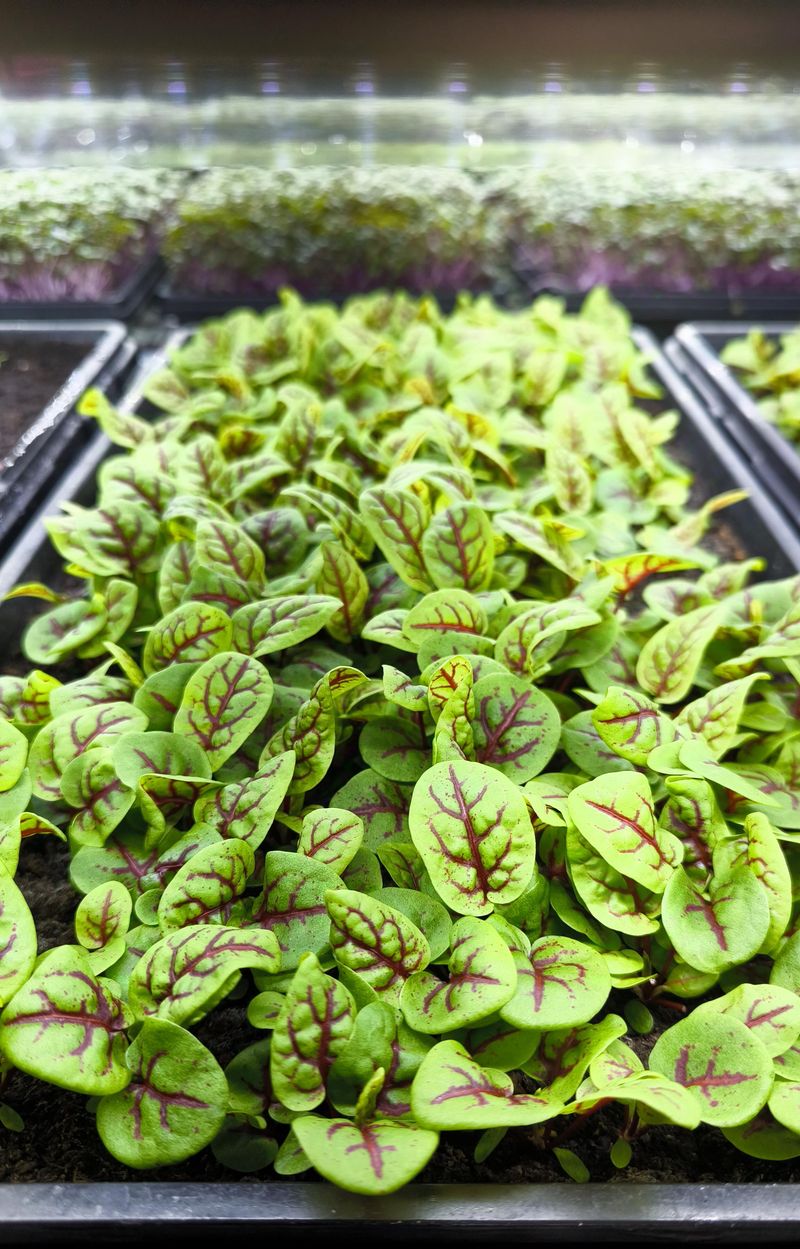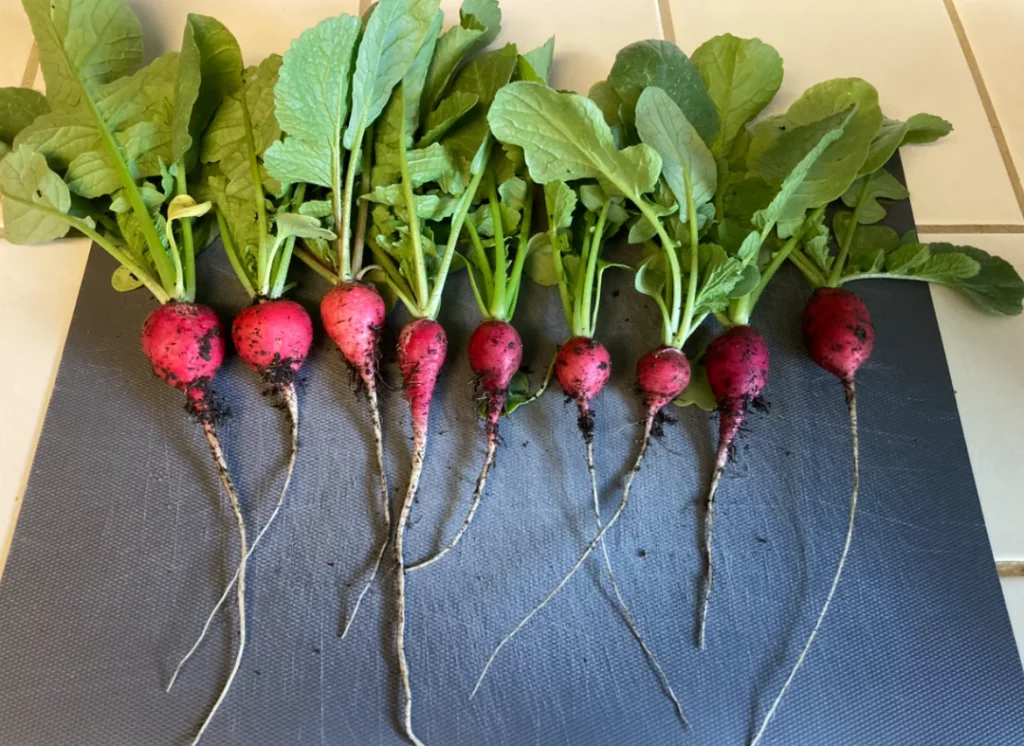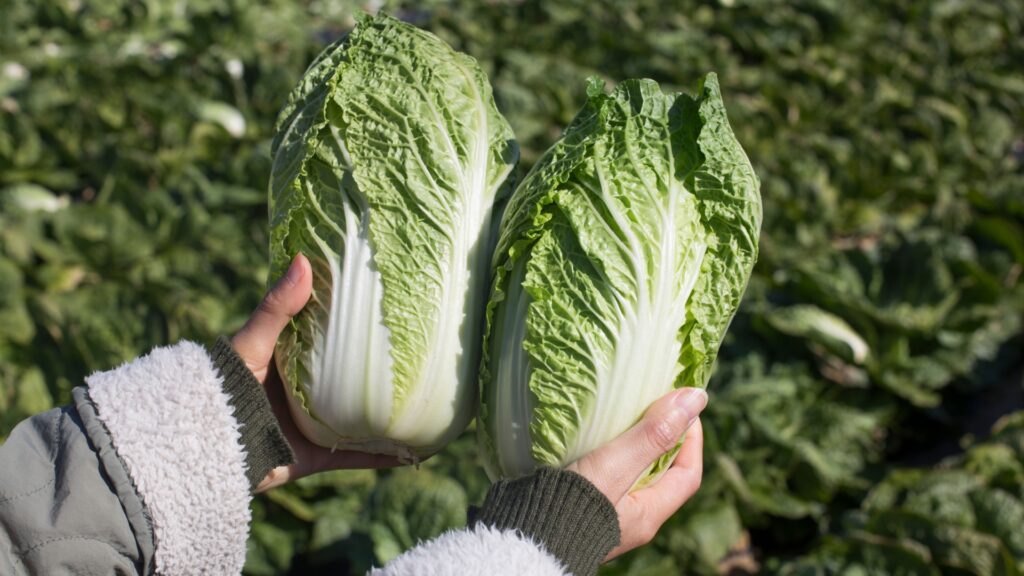Imagine snipping your veggies and watching them bounce back like they never left—no replanting, no fuss. Sounds like garden magic, right?
Well, it’s real! I’ve rounded up 22 comeback kings of the veggie world—plants that regrow after harvest, practically doing the hard work for you.
Whether you’ve got a green thumb or you’re just testing the waters, these low-maintenance legends will keep your kitchen stocked and your garden thriving. It’s the gift that keeps on growing!
1. Green Onions
Snip off the tops, and they’ll grow right back. Green onions, also known as scallions, are remarkably resilient. When you trim them, leave about an inch above the roots and place them in water. In just days, you’ll notice new growth. Their peppery, fresh taste makes them perfect for garnishing dishes. Whether in salads or stir-fries, these regrowing wonders add a crisp, spicy note that you’ll love. Keep them on your windowsill, and enjoy a continuous supply that brightens your meals and reduces waste. Cultivating green onions is simple and rewarding.
2. Garlic
Even a single clove can sprout into something new. Garlic, with its robust flavor, begins regrowing nearly effortlessly. Plant a clove with the root side down, and watch as green shoots emerge.
Harvest these shoots for a milder garlic taste that’s perfect for enhancing soups and sauces. Garlic’s adaptability to regrow adds convenience to your kitchen.
Plus, it’s a delightful experiment in sustainability. Witnessing nature’s cycle firsthand provides satisfaction. Whether you’re a novice or seasoned gardener, garlic offers a practical and flavorful addition to your garden.
3. Leeks
Cut them, and they come back again. Leeks, with their subtle onion flavor, are a gardener’s delight. When you slice off the top, leave the root end intact.
Place it in a shallow dish of water, and soon you’ll see new growth. Their gentle taste complements soups, stews, and casseroles beautifully. Growing leeks at home means you’ll always have this versatile vegetable on hand.
Enjoy the satisfaction of harvesting fresh leeks continually, enhancing your culinary creations with their unique and delicate flavor. It’s an easy and practical gardening choice.
4. Lettuce
A fresh salad is just a snip away. Lettuce can regrow from the base after cutting the leaves. Place the root in water, and it will soon sprout new leaves.
This process offers endless possibilities for fresh salads and garnishes. The mild, crisp taste of homegrown lettuce is unmatched. With minimal effort, you can have a constant supply of this leafy green. Its convenience and delightful flavor make lettuce a staple in any garden.
Regrowing lettuce not only saves money but ensures the freshest produce right at your fingertips.
5. Celery
Save the base of your celery and pop it in a dish with water, root-side down. Within a few days, you’ll notice new leafy shoots emerging from the middle.
It’s like celery’s doing a comeback tour right in your kitchen! Change the water regularly, and give it sunlight to help it thrive. The more love, the faster it grows.
Once roots appear, transfer it to soil to grow fuller stalks. Water it well and watch it turn into a lush, crunchy plant. You’ll get a steady supply of fresh celery without heading to the store.
Plus, the leafy tops are great in broths and salads. Who knew leftovers could be this powerful?
6. Bok Choy
Cut off the leaves and save the bottom inch of the base. Pop it in water and put it in a sunny spot—you’ll see fresh green shoots in just a few days.
It’s like getting a second helping from the same veggie. Keep the water clean, and it’ll continue to surprise you. Those new leaves are perfect for stir-fries or soups!
For long-term growth, plant it in soil after the roots develop. Bok choy thrives in moist soil and partial sun. It’ll grow into a compact, leafy powerhouse in no time.
You can harvest the outer leaves and let the center keep producing. It’s a regrowth superstar with plenty of flavor.
7. Cabbage
After you cut off the leafy head, leave about 2 inches of the core and place it in a shallow bowl of water. Put it in sunlight and watch new leaves start sprouting from the center. It’s like a cabbage phoenix rising from the base!
Change water every few days and keep it cozy. In no time, baby cabbage leaves will be ready to harvest.
Transplant it to soil for more serious regrowth. Cabbage loves cool temps and regular watering. Keep trimming the outer leaves as the inner ones flourish.
It may not grow a full head again, but those tender greens are gold. Who says cabbage only gets one shot?
8. Kale
Kale is one of the easiest leafy greens to regrow from cut stems. Just place a kale stalk in a glass of water, and tiny roots will start forming.
Once rooted, transfer it to soil and watch it take off. It loves sun and regular watering, so treat it well. Soon, you’ll be plucking nutrient-packed leaves again and again!
Cut the outer leaves and let the inner ones keep growing. This encourages a bushier plant and a continuous harvest. It’s a great way to keep your smoothie game strong.
Kale’s regrowth power makes it a backyard or windowsill hero. Plus, it adds style and color to your edible garden.
9. Spinach
Snip your spinach leaves, but leave a few inches of the base intact. Place it in water and let it soak up some sunshine.
Before you know it, fresh greens will start to pop from the center. Keep the water clean, and it’ll keep on giving. You’ll have crunchy, tender leaves ready in no time.
Spinach does even better when moved to soil after rooting. It prefers cool weather and moist soil, so keep it hydrated. Harvest the larger outer leaves and let the rest keep growing.
It’s like a living salad you can trim and toss on demand. Perfect for quick, fresh meals.
10. Swiss Chard
Cut the stalks but leave about an inch of the base, and set it in water. Soon, vibrant green leaves and colorful stems will start to push through.
It’s a showstopper in your kitchen and your plate! Change the water often, and give it light to thrive. In no time, you’ll have fresh chard for sautés, wraps, or smoothies.
Once roots appear, transfer it to soil for even more growth. Swiss chard is a tough, cold-hardy plant that keeps on producing. Snip outer leaves and let the center flourish—it’s built for regrowth.
With its rainbow hues, it adds color to both your garden and your meals. A true garden gem that keeps on giving.
11. Mustard Greens
Cut the leaves but leave a couple of inches above the root. Pop the base in a shallow dish of water, and fresh shoots will begin to sprout in a few days.
These zesty greens come back fast and full of flavor. Just give them light, clean water, and a little patience. They’ll reward you with bold, peppery goodness.
Once roots appear, plant it in soil for even stronger growth. Mustard greens love cool weather and moist dirt, making them perfect for windowsills or balcony pots.
Snip the outer leaves as they mature and let the plant keep producing. It’s a low-effort, high-reward green. Great for adding a little kick to your dishes!
12. Arugula
Leave a couple of inches at the base after harvesting your arugula leaves. Place the stump in a dish of water, and soon enough, it’ll send out new leafy growth. Keep it in a sunny window and watch the peppery greens bounce back.
Change the water often to keep things fresh. These baby leaves are full of bite and energy.
Transplant to soil once roots start forming and you’re in for endless flavor. Arugula grows quickly and doesn’t ask for much—just sun and steady watering.
Pick the outer leaves and let the rest thrive. It’s perfect for microgreens or full-sized leaves depending on how long you let it grow. A gourmet salad on demand? Yes, please.
13. Collard Greens
Chop off the leaves but keep the base intact and pop it into some clean water. Give it a little sunlight, and it’ll start growing fresh new leaves from the center.
Within a week or so, you’ll see its deep green comeback. Keep the water fresh and let those vibrant leaves stretch. It’s a hardy plant that doesn’t mind being regrown.
Once the roots are ready, move it into soil and it’ll grow even bigger and better. Collards are tough and generous—just water them regularly and keep them in partial to full sun. You can keep harvesting outer leaves and let the plant keep going.
They’re perfect for wraps, sautés, or soul food staples. Southern flavor straight from your windowsill!
14. Basil
Snip a basil stem about 4 inches long and place it in water, making sure to remove the lower leaves. In a sunny spot, you’ll see roots start to grow within a week.
It’s like your own little herb lab on the windowsill. Once the roots are a couple of inches long, move it to soil for a never-ending basil boost. Hello, fresh pesto whenever you want!
Basil loves warmth, light, and regular pinching to stay bushy. Just trim above a pair of leaves, and two new branches will grow in its place. Keep harvesting and it’ll keep thriving.
It’s a kitchen garden MVP with a big personality. Plus, it makes your space smell amazing!
15. Mint
Cut a few healthy mint stems and place them in water, making sure a few nodes are submerged. Within days, roots will start appearing like magic.
Give it light and fresh water, and those fragrant green leaves will flourish. Once rooted, transfer to soil—it grows like a dream. Just be careful, mint is a wild one and spreads fast!
Keep it in a container to control its growth, and it’ll keep giving you refreshing flavor for months. Snip the top leaves to encourage bushier growth. It’s perfect for teas, desserts, or mojitos on demand.
With minimal effort, you’ll have a mint jungle at your fingertips. Fresh breath and good vibes all around!
16. Cilantro
Take the bottom stems of cilantro and place them in water—roots will begin to form in under a week. Once they’re ready, plant them in soil and give them sun and water love. In no time, you’ll have new, fragrant leaves popping up.
This herb may be a little finicky, but once it’s rooted, it thrives. The flavor? Totally worth it.
Harvest the outer leaves and let the inner ones keep growing. Cilantro does best in cooler temps and well-drained soil. Keep it from flowering to extend its growing season.
It’s like having your own taco topping garden on standby. Fresh and punchy, just how you like it!
17. Parsley
Place parsley cuttings in a glass of water with the leaf nodes submerged. Give it some sunlight, and you’ll see roots sprouting in about a week.
Once rooted, plant in soil and it’ll turn into a leafy green machine. Parsley is pretty low-maintenance and keeps on giving with regular trimming. Those bright green sprigs are always a kitchen win.
Snip the outer stems and let the center grow strong. Water it regularly and keep it in partial to full sun. The more you cut, the more it grows—how cool is that?
Great for garnishing, flavoring, or tossing into just about everything. Fresh parsley on demand is a chef’s secret weapon.
18. Fennel
Cut the bulb, but leave the root base intact and place it in a shallow dish of water. With sunlight and a little patience, green fronds will start pushing through the center. It’s like the plant’s waving hello! These flavorful greens are perfect for soups, salads, or garnishes. Change the water every few days to keep it healthy.
Once roots form, move it to soil and watch it flourish.
Fennel loves full sun and moist soil, and it can regrow its bulb if you’re lucky. It’s both beautiful and useful, with a gentle licorice flavor. Harvest fronds as they grow and let the plant keep thriving. A gourmet favorite that brings elegance to any dish.
19. Turnip Greens
After chopping off the leafy tops, place the turnip root base in water and let it sit in sunlight. In a few days, you’ll see bright green leaves starting to sprout.
These greens are bold, peppery, and packed with nutrients. Change the water regularly to keep it happy. You’ll have a fresh new batch of leaves in no time.
Transplant to soil for a fuller, long-term harvest. Turnip greens love cool temps and consistent moisture. Keep snipping outer leaves and they’ll continue to grow strong.
Bonus: if you leave the root, it might regrow the turnip too! It’s a two-for-one veggie powerhouse.
20. Beet Greens
Save the beet tops and place the cut side down in a shallow bowl of water. Sunlight will coax out fresh leafy greens from the center. They’re tender, slightly earthy, and great for sautéing or juicing.
You won’t get a new beet this way, but the leaves are a treat on their own. Keep the water clean and the greens coming.
Once the roots appear, move the tops to soil for a sturdier regrow. Beet greens grow quickly and thrive in cool conditions. Trim leaves as needed, and more will follow.
It’s a colorful and nutrient-rich way to reuse your veggie scraps. Your compost pile’s loss is your skillet’s gain!
21. Carrot Greens
Chop off the top inch of your carrot (with the green sprout area) and set it in a shallow dish of water. In a few days, you’ll notice fresh, feathery greens emerging from the crown. These aren’t just pretty—they’re edible and great for pesto, soups, or garnishes.
Keep the dish in a sunny spot and change the water regularly. Watch your kitchen scraps turn into leafy wonders!
Though they won’t regrow full carrots, the greens are surprisingly flavorful. You can also plant the tops in soil for a longer-lasting harvest. Trim the greens as needed and let the rest flourish.
They’re like the bonus track on a vegetable album—unexpected and totally worth it. A little sunlight goes a long way!
22. Radicchio
Leave the base of the radicchio intact and set it in a bowl with just enough water to cover the roots. Place it in a sunny window, and within days, you’ll spot fresh red-purple leaves curling up from the center. It’s a bold beauty with attitude! Change the water every few days to keep things fresh. In just over a week, you’ll have fresh new leaves to enjoy.
Transplant to soil once roots develop for a more robust regrowth. Radicchio loves cool temps and rich soil. Harvest the outer leaves and let it keep growing strong.
Its bitter edge makes salads pop and sautés sing. Growing it again feels like unlocking a little culinary cheat code.
23. Watercress
Snip a few stems and place them in a glass of water, submerging the bottom ends. These little greens root fast and grow like crazy with just a little sunlight. You’ll see new leaves in under a week—tender, peppery, and oh-so-fresh.
Refresh the water every few days and keep trimming to encourage bushy growth. Watercress is small but mighty!
Once rooted, pop it into soil or even let it trail in a water garden. It loves moisture and partial shade, thriving in conditions other plants avoid. Harvest leaves regularly to keep it coming. It’s a fancy-feeling green that’s surprisingly easy to grow.
Perfect for sandwiches, salads, and all things fresh and crisp.
24. Chives
Take a few chive bulbs or leftover roots and stick them in water—within days, you’ll see new green shoots stretching upward. These slender, oniony stems grow fast and furious in a sunny windowsill. Snip them when they’re long enough and let the rest regrow.
You’ll have a continuous supply for eggs, dips, and soups. It’s like growing garnish on demand.
Chives can also be planted in soil once rooted, making them even more productive. The more you harvest, the more they bounce back. Keep them moist and they’ll stick around for the long haul.
Plus, their tiny purple flowers are edible too. Stylish and tasty? Yes, please.
25. Oregano
Grab a healthy oregano cutting and place it in water with the lower leaves removed. Give it a sunny windowsill, and roots will start to form in a week or so. This Mediterranean herb thrives with light and a little patience. Once rooted, move it to soil and let it sprawl. Its bold aroma is a kitchen essential!
Trim the tips to encourage bushy, full growth. Oregano loves to be used—regular snipping keeps it productive. Let it dry, use it fresh, or infuse it into oil. However you use it, it just keeps coming back. A little pot of oregano adds big flavor with minimal effort.
26. Thyme
Cut a sprig of thyme and place it in a glass of water with just the nodes submerged. Within a week or two, tiny roots will start to emerge, ready for soil.
Give it bright light and a bit of love, and it’ll reward you endlessly. This woody herb is slow but steady—and full of flavor. From soups to roasts, thyme brings the magic.
Once planted, it grows into a low, fragrant mat you can snip as needed. Keep it well-drained and don’t overwater—it likes things dry and sunny. The more you trim, the bushier it gets.
Thyme practically thrives on neglect. And when your kitchen smells like a cozy forest, you’ll know it’s working!
27. Lemongrass
Place the stalk base in a cup of water and set it in sunlight—roots will appear within days, and green shoots will soon follow. It’s fast, fragrant, and surprisingly low maintenance.
Once it’s rooted, transfer it to a pot or garden bed and let it grow tall. Trim the outer stalks and let the center keep pushing up. It’s like growing your own spa.
Lemongrass loves warm temps and full sun. With enough space, it’ll grow into a big, bushy plant you can harvest again and again. Use the stalks for teas, broths, or stir-fries. The scent alone will transport you. Bonus: it also repels mosquitoes!
28. Pea Shoots
Take leftover pea seeds or sprouted peas and place them in shallow soil or a wet paper towel. Within days, slender shoots will pop up, reaching for the light.
These crunchy, sweet greens are ready to harvest in under two weeks. Just snip them above the first set of leaves and they’ll regrow quickly. They’re like green confetti for your plate!
Keep them moist and in a sunny spot for best results. The more you trim, the more they thrive. Pea shoots are perfect for sandwiches, salads, and stir-fries. Their delicate tendrils make them extra charming. It’s like growing sunshine you can eat.
29. Sweet Potato Greens
Place a sweet potato half-submerged in water, toothpicks holding it in place. In about a week, leafy vines called “slips” will begin to grow. These greens are not only beautiful but totally edible—earthy, mild, and nutritious.
Once the slips are a few inches long, you can cut and plant them in soil. Boom—endless greens and maybe more sweet potatoes, too!
Sweet potato vines grow fast with light and warmth. Snip the leaves regularly and new ones will pop right back.
They’re perfect for sautéing or tossing into stir-fries. A vibrant, climbing addition to your kitchen garden. Edible and ornamental? That’s a win-win.
30. Sorrel
Leave a few inches of the base after harvest, and plant it directly into soil or set it in water to root. This tart, lemony green bounces back fast with some sunlight and moisture.
You’ll see fresh leaves within a week or two—perfect for salads, soups, and sauces. The more you harvest, the more it produces. Sorrel doesn’t mess around!
It thrives best in cool weather and partial sun. Keep the soil damp but not soggy, and it’ll keep on giving. Snip from the outer edge and let the center regrow. It’s a little less common, but once you grow it, you’ll wonder how you ever lived without it. Sharp, bright flavor—right at your fingertips.
31. Radishes
After harvesting the radish root, leave about an inch of the root intact and place it in water. In just a few days, you’ll see fresh green tops sprouting again! These leafy greens are perfect for adding a peppery flavor to your salads, sandwiches, or garnishes.
While you won’t regrow a full radish root, the greens are a delightful bonus for your kitchen. Move the plant to soil once the roots start forming for continuous growth.
Radishes thrive in cooler weather and can provide you with an extra, flavorful crop when you need it most. A quick and simple way to add some zing to your dishes!
32. Napa Cabbage
Cut the leafy top and keep about two inches of the stem base. Place it root-side down in a shallow bowl of water, and in just a few days, you’ll see fresh leaves peeking out from the center. It’s like your cabbage is coming back for an encore!
Change the water every couple of days and give it plenty of light. Once roots begin to form, you can transplant it to soil for a more lasting harvest. Napa cabbage thrives in cooler temperatures and loose, moist soil.
Snip the outer leaves and let the center continue growing. These tender, slightly sweet greens are ideal for stir-fries, wraps, or homemade kimchi. It’s a regrow-friendly veggie with tons of flavor and personality—great for beginners and food lovers alike!

